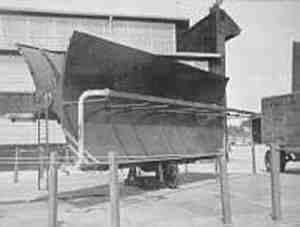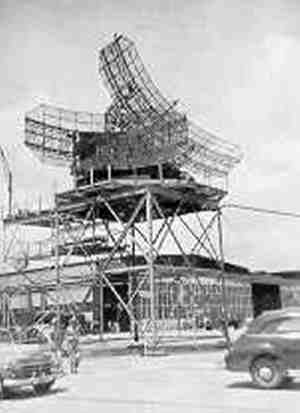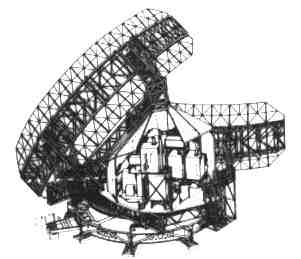AN/CPS-1 and AN/CPS-6 at Keesler AFB, MS
The AN/CPS-1 and AN/CPS-6 radar photos below, taken by Chuck Rowland at Keesler AFB, MS, are dated 1950.

CPS-1 Antenna

CPS-6 Antenna
The AN/CPS-1 and AN/CPS-6 radar photos below, taken by Chuck Rowland at Keesler AFB, MS, are dated 1950.

CPS-1 Antenna

CPS-6 Antenna
 The AN/CPS-6 (-6A, -6B) was developed during the later stages of World War II by the Radiation Laboratory at MIT. The first units were produced in mid-1945. General Electric developed and produced the A-model and subsequent B-model at a plant in Syracuse, New York. The unit consisted of two antennas. One of the antennas slanted at a forty-five degree angle to provide the height-finder capability. Initially, the radar was designed to detect fighter aircraft at 100 miles and 16,000 feet. The radar used five transmitters that operated at S-band frequencies ranging from 2700 to 3019 MHz. It took twenty-five people to operate the radar. An AN/CPS-t radar was installed as part of the Lashup system at Twin Lights, New Jersey, in 1949 and proved capable of detecting targets at ranges of eight-four miles. The first units of the follow-on-6B radar set were ready for installation by mid-1950. Fourteen -6B units were used within the first permanent network. A component designed to improve the radar`s range was added in 1954. Initial tests showed the -6B unit had a range of 165 miles with an altitude limit of 45,000 feet. One radar unit and its ancillary electronic equipment had to be transported in eighty-five freight cars. The Air Force phased out the -6B model between mid-1957 and mid-1959.
The AN/CPS-6 (-6A, -6B) was developed during the later stages of World War II by the Radiation Laboratory at MIT. The first units were produced in mid-1945. General Electric developed and produced the A-model and subsequent B-model at a plant in Syracuse, New York. The unit consisted of two antennas. One of the antennas slanted at a forty-five degree angle to provide the height-finder capability. Initially, the radar was designed to detect fighter aircraft at 100 miles and 16,000 feet. The radar used five transmitters that operated at S-band frequencies ranging from 2700 to 3019 MHz. It took twenty-five people to operate the radar. An AN/CPS-t radar was installed as part of the Lashup system at Twin Lights, New Jersey, in 1949 and proved capable of detecting targets at ranges of eight-four miles. The first units of the follow-on-6B radar set were ready for installation by mid-1950. Fourteen -6B units were used within the first permanent network. A component designed to improve the radar`s range was added in 1954. Initial tests showed the -6B unit had a range of 165 miles with an altitude limit of 45,000 feet. One radar unit and its ancillary electronic equipment had to be transported in eighty-five freight cars. The Air Force phased out the -6B model between mid-1957 and mid-1959.
Source: Searching the Skies - USAF Air Combat Command